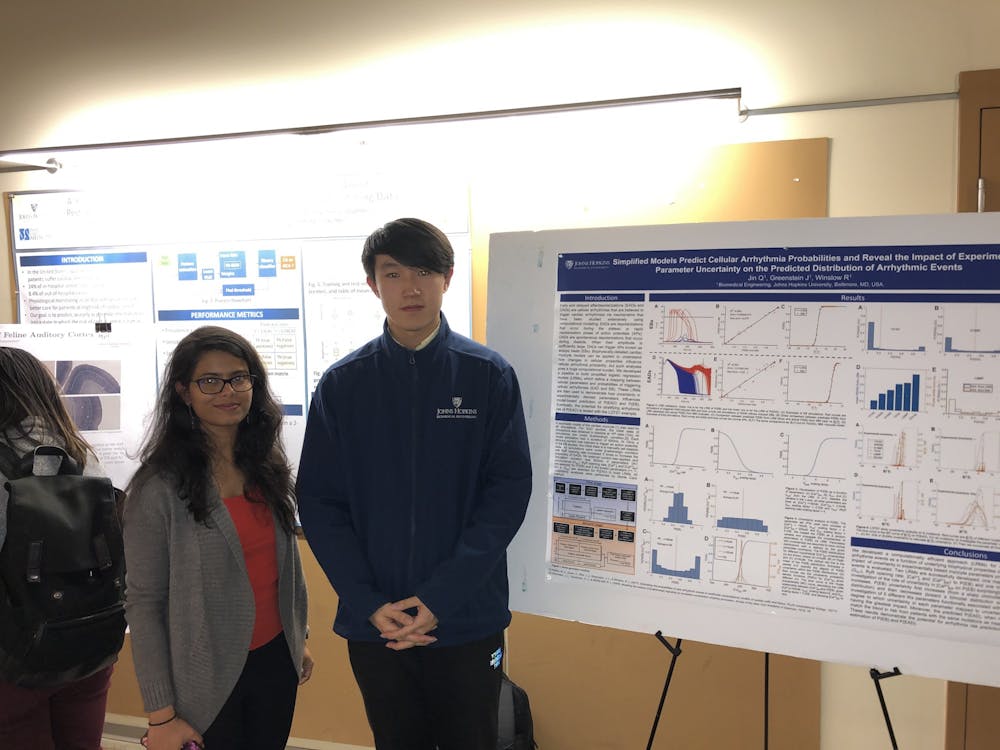Computational Medicine Night, which was held on March 3, offered students a chance to learn more about the undergraduate computational medicine minor and meet academics in the field.
“Medicine is becoming an engineering discipline,” said Raimond Winslow, the Raj and Neera Singh professor of Biomedical Engineering and the director of the Institute for Computational Medicine (ICM).
Winslow coined and popularized the term “computational medicine” (CM) and founded ICM, the first and largest institute of its kind. The field of computational medicine, which is interdisciplinary by nature, involves the development of computer models of human diseases like cancer, HIV/AIDS and neurological disorders. The models can be personalized for individual patients and used to improve and diagnosis and treatment.
“Physicians’ mental models just aren’t accurate enough to incorporate how much data there is floating around,” Winslow said. “Physicians will remain the tip of the spear in terms of treating patients, but CM tools will be used to make physicians’ jobs significantly easier, as we’ll find out lots of clinical correlations that physicians have missed.”
The event also showcased student research. Senior Kathy Hu presented her novel work on seizure onset zones, places of origin for focal seizures in the brain. The News-Letter caught up with Hu for an interview after her presentation.
Hu’s project was related to epilepsies. She explained that about 20 million people have medically refractory epilepsy, which are seizures that do not respond to typical medical treatments. Of those, about half suffer from focal seizures. Focal seizures consistently originate from a small defined region in the brain called the seizure onset zone (SOZ).
To treat those patients, surgeons first record brain activity through invasive electroencephalograms (EEG). However, it can take days or even weeks to capture the exact location of the SOZ to resect it. According to Hu, the success rates of those surgeries are quite low.
“First-time surgeries are only successful 50 percent of the time, and the length of time the patient is in the hospital can extend to days or weeks,” she said.
Hu and the principle investigator of her lab, Sri Sarma, noticed that EEG data from SOZs showed very similar patterns to one another and very different patterns from other regions of the brain during seizures. They wondered if the same was true in a non-seizure state. As it turns out, it was.
“We’ve built models showing how SOZs have abnormal EEG data even during non-seizure events. Now we’ve managed to show that recording SOZs for just seven minutes improves SOZ localization 10-fold,” Hu said.
Compare this time to the days or weeks taken previously and one can imagine the significant cost and infection risk decrease to both the patient and the hospital. Further work involves continued improvement of the model and a determination of the most useful time to take the data to glean the most significant results.
CM encompasses far more than just epilepsy. The News-Letter also spoke to Qingchu Jin, a CM graduate student researcher in the Winslow lab.
Jin works with a simplified model of a heart tissue called a myocyte. He uses statistical modeling techniques to derive a more mechanistic model of arrhythmias, which are heartbeat irregularities.
“There are five kinetic parameters across 19 locations, and we’re using that data to do the modeling. We’ve found that we can predict the probability of an arrhythmia happening and that our prediction is highly correlated with clinical outcomes,” Jin said.
Despite the variety of research presented at the ICM Night — other students presented work in the use of machine learning to predict protein structure and diagnose ADHD — it was clear that all projects required significant computational skill to carry them out. The Computational Medicine minor allows students to hone those skills through a formal curriculum.
There are four focus areas: computational physiological medicine, computational molecular medicine, computational anatomical medicine and computational health care.
As the first of its kind in the nation, the ICM continues to lead and devise new treatment paradigms using the power of computation. The research presented on Computational Medicine Night made it seem, as Winslow said, that medicine will become a subdiscipline of engineering.





